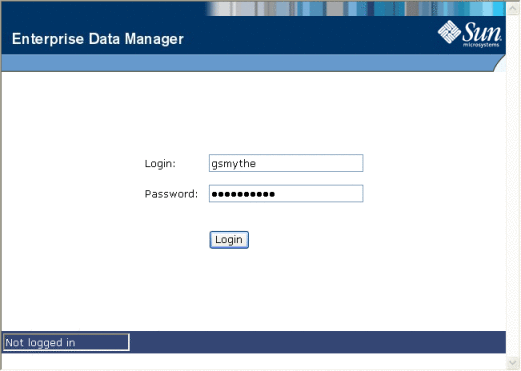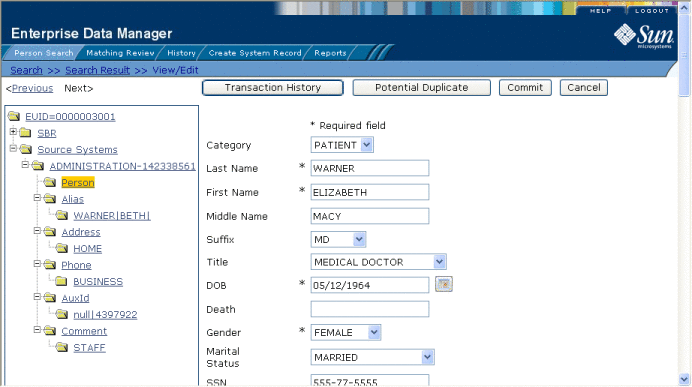Working with the Patient EDM
The Patient EDM is a web-based application, which means you access the application through an internet browser. The Patient EDM uses standard web-based features, such as hyperlinks, data fields, and action buttons, to help you enter information and navigate through the different Patient EDM pages. The following topics provide basic information about the design of the Patient EDM and logging in to and out of the application.
Logging in to the Patient EDM
Before you can use the Patient EDM, you must first log in to the application by entering the correct URL in your web browser, and then specifying your login ID and password. Make sure you have a user ID and password for Sun Master Patient Index before logging in. The application server running Sun Master Patient Index must be started before you can log in to the Patient EDM.
The URL for the Patient EDM is:
http://host:port/app_nameedm |
where
-
host is the name of the server machine.
-
port is the port number used by the Patient EDM.
-
app_name is the name of the Sun Master Patient Index application (typically, app_name is Person) .
The port number for the Sun Java System Application Server is listed in the domain.xml file in the http-listener element (8080 by default). The domain.xml file is located in app_server_home\domains\domain_name\config.
 To Log in to the Patient EDM
To Log in to the Patient EDM
-
Launch a web browser (Internet Explorer 6.0 with SP1 or later).
-
In the Address field, enter the appropriate URL.
The Login page appears.
Figure 2 EDM Login Page

-
Enter your login ID and password in the appropriate fields.
-
Click Login.
The initial page appears. (By default, the initial page is the Search page, but this is configurable.)
Note –After a certain period of inactivity, the Patient EDM automatically logs off and returns you to the Login page when you try to perform an activity on the Patient EDM. Simply reenter your user name and password to access the Patient EDM again. The system administrator can set the inactivity period at the server level in the session-timeout element of default-web.xml (in logicalhost_home\is\domains\domain_name\config) or at the application level in web.xml in the Sun Master Patient Index application .war file (located in the deployment .ear file) or in the deployment folder itself. The application level overrides any values set at the server level. The default inactivity period is 30 minutes.
Security Permissions for the Patient EDM
Security for the Patient EDM is defined at the function level. You might not be able to perform all the functions described in this guide depending on the security permissions you are assigned. For more information about functions you can perform, see your system administrator.
Navigation Tips for the Patient EDM
The Patient EDM provides hyperlinks and command buttons to help you access and move through the Patient EDM pages. When you place the cursor over links and images on the Patient EDM pages, tooltips appear to provide additional information. Information is also provided to facilitate the use of screen readers and other assistive technology.
Navigating the Patient EDM Functions
The actions you can perform on the Patient EDM are grouped into five primary functions: Person Search, Matching Review, History, Create System Record, and Reports. The main menu on all Patient EDM pages provides hyperlinks to each of these functions, as shown in Figure 3. The first page to appear for each function, except the Create System Record function, is a search page. The names of these headings can be modified for your application.
Figure 3 Main Menu Navigation Tools

-
Person Search – The Person Search function allows you to perform a search for a patient profile or set of patient profiles in Sun Master Patient Index. From the associated pages, you can compare two patient profiles, compare records in one patient profile, view all information for one patient profile, update a patient profile, view a transaction history of a patient profile, view a patient’s potential duplicates, or merge patient profiles or system records.
-
Matching Review – The Matching Review function allows you to perform a search for potential duplicate profiles or for any profiles that were updated by an assumed match. From the associated pages, you can compare, merge, or resolve potential duplicate profiles, and you can view and reverse assumed match transactions.
-
History – The History function allows you to perform a search for transaction histories or audit log entries. From the Transaction History pages, you can compare information about a patient before and after a transaction occurred, select patient profiles to unmerge, and view a merge history for a patient profile. From associated Transaction History pages, you can unmerge patient profiles. The audit log pages allow you to view information about transactions in which data about a patient was accessed through the Patient EDM.
-
Create System Record – The Create System Record function allows you to create new patient profiles by creating a system record. When you save the information in the system record, Sun Master Patient Index automatically generates the SBR using the survivor calculator.
-
Reports – The Reports function allows you to display and print reports about certain transactions performed from both the Patient EDM and from messages sent in from external systems. For information on configuring reports, see Understanding Sun Master Index Configuration Options (Repository). For information about running reports from a command line, see Maintaining Sun Master Indexes.
Navigating the Search Pages
When you perform a search for patient information using the Person Search, History, or Matching Review functions, information appears in three different pages. The Search page displays the fields you can use as search criteria, the Search Result page displays a list of search result profiles, and the detail pages display the patient profiles you select from the results list. Once you perform a search, you can navigate back through these pages using the hyperlinks provided in a secondary menu below the main menu, as shown in Figure 4. The Matching Review page for potential duplicate searches includes an additional results page called the Associated Records page.
Figure 4 Search Page Navigation Tools

The behavior of the commands on the secondary menu for Person Search, Matching Review, and History is described in Table 2.
Table 2 Secondary Menu Navigational Tools|
Menu Option |
Description |
|---|---|
|
Returns to the original search page with the search criteria filled in. |
|
|
Returns to the search results list. |
|
|
Detail Page Name |
This is the name of the current detail page. Clicking this menu option does not perform any action unless you perform a merge from the Comparison page. In this case the Comparison option becomes active and returns to the Comparison page. |
|
This option becomes available when you select Transaction History or Potential Duplicate from the View/Edit page. It returns to the View/Edit page. |
Navigating the Detail Pages
The detail pages display an EUID tree view of the patient profile on the left and the detailed information for the selected tree-view object on the right. If you are viewing a comparison of patient profiles, the tree views appear in the outer sections of the page, with the detailed information in the center. Figure 5 illustrates the View/Edit page and shows the tree view on the left with the person object of the SBR selected. The detailed information displayed on the right is associated with the selected patient profile. When you select a different object from the tree view, the detailed information in the right portion of the page changes accordingly.
Figure 5 Sample View/Edit Page

Logging Out of the Patient EDM
Before you exit the Patient EDM, make sure you have saved any changes. To exit the Patient EDM, click Logout in the upper right corner of the page. The Login page reappears.
- © 2010, Oracle Corporation and/or its affiliates
